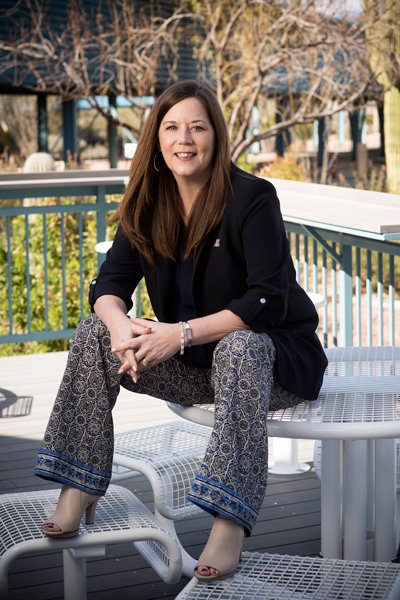|
Getting your Trinity Audio player ready...
|
Managing a technology park demands a certain type of individual who is comfortable dealing with the unknown regularly. There’s no formal training. “Nobody goes to school for that,” says Carol Stewart, associate vice president of Tech Parks Arizona for the University of Arizona. “You have to be predisposed to finding your way—finding new solutions day to day.”
A perfect example of handling the unknown was during the COVID-19 pandemic. In March 2020, executives at Tech Parks Arizona faced an unprecedented situation and needed to adapt quickly. “We were in a fetal position for twenty-four hours,” Stewart says. “Then we developed a strategy, and everybody had to pivot at a rapid pace.”

Stewart drew upon disaster preparedness plans for guidance. “We did not have a plan for a pandemic,” Stewart says. “We had to adapt for the situation.”
Though many of the six thousand employees shifted abruptly to remote work, that wasn’t an option for all. Ongoing lab experiments would have been jeopardized with a blanket shutdown.
Management quickly devised policies to safely keep the flagship campus, the UA Tech Park at Rita Road, open. Communication with each individual company increased to ensure tenant needs were met. Janitorial staff beefed up cleaning regimens. Air filtering was enhanced. New cameras were installed to improve security and monitor the occupied density of spaces.
The park also offered technology platforms and online services to help employees work remotely. About 75 percent of tech park employees switched to telecommuting. It was a fairly smooth transition with all of the businesses able to continue to operate.
That’s a sharp contrast from most other technology parks, Stewart says. “There are two hundred research parks in North America,” she notes. “And within the parks are technology incubators, which from my experience are the heart of successful parks. These incubators support early stage startups with critical business support giving them the best chance at success.
“You have to be predisposed to finding a way—finding new solutions day to day.”
“This is a very critical time for startups,” Stewart adds. “Nationally, we are seeing 40 percent to 70 percent of startups close. However, we have not lost one here.” Stewart continues to check in daily with executives of each company to find ways park management can help them thrive.
While business activity continued at the flagship tech park, construction at two new sites had to be assessed. UA Tech Park at the Bridges, part of a large multiuse development in central Tucson, calls for 1.8 million square feet of office and laboratory space that could support up to ten thousand employees. Site preparation and infrastructure work was briefly paused, and then quickly ramped up to keep the project on schedule.
The University of Arizona Center for Innovation at Oro Valley was also in early construction phases when the nationwide shutdown occurred. This project will have roughly 4,000 square feet of office and lab space dedicated to incubating nascent bioscience businesses. Construction work also resumed after a brief shutdown, and the project is on schedule.
Tech Parks Arizona’s growth is familiar to Stewart. She guided the David Johnston Research + Technology Park, affiliated with the University of Waterloo in Ontario, Canada, from its inception to over 1 million square-foot of innovation facilities. “It went from a cornfield to a world-renowned research park that is anchored by a globally ranked business incubator,” Stewart says.
“It’s all about relationships. How do you form relationships when you can’t have a traditional business lunch? You have to get creative, and that’s what we did.”
Stewart is a widely recognized leader in the technology park world, having served as the CEO of the Association of University Research Parks, which represents two hundred research parks across the world. In this role, she influenced national policy in Canada, created standardized programs for tech parks, helped establish national and international business networks, and assisted countries with the development of their national science and technology policies.
Tech Parks Arizona, a quarter century old when Stewart took the reins in December 2018, with a track record of success and potential for rapid growth—an exciting reason to make the move. With Tech Parks Arizona entering a new, vibrant phase, the opportunity to take best practices and lessons learned to a new level was too much to pass up.
Working with a seasoned team, Stewart found ways to continue to recruit new businesses amid the pandemic. “It’s all about relationships,” she says. “How do you form relationships when you can’t even have a business lunch? You have to get creative, and that’s what we did.”
One answer was developing a program called “Tamales and Tech Parks”—virtual meetings catered by a local eatery. Because Tucson is rich in thriving food traditions and culinary distinctiveness, Tech Parks brought a bit of Tucson food to people across the nation. The restaurant shipped their locally revered tamales to executives from companies interested in opening locations in Tucson. The remote business lunches literally captured the flavor the Southwest.
With its strategic advantage location, numerous amenities, ample space, and endless potential to a talent pipeline of intelligence and research expertise, prospects for Tech Parks Arizona remain bright.
Indeed, though Tucson is thousands of miles from Waterloo, and a world away climatologically, it’s beginning to feel like home.















